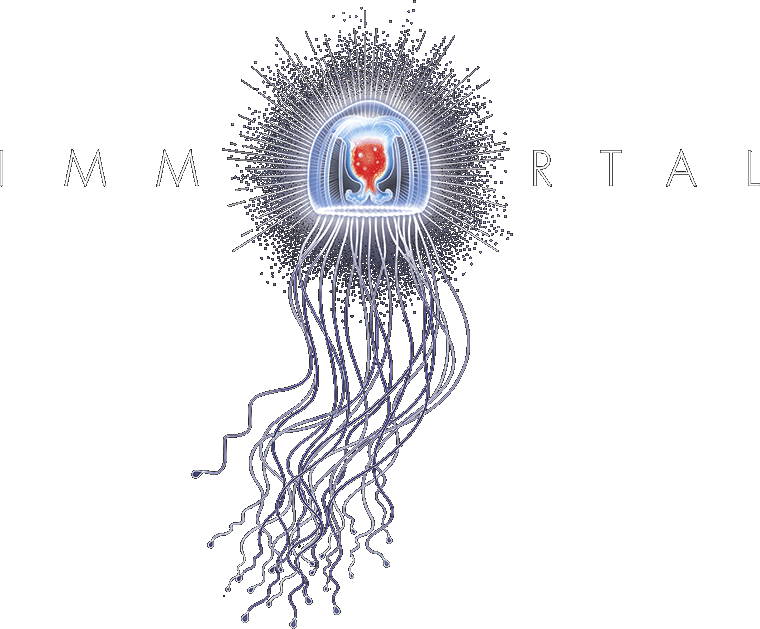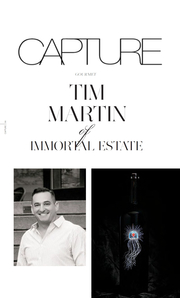TIM MARTIN IMMORTAL ESTATE
CAPTURE: Tell us how Immortal Estates came about, and the story behind the name and the jellyfish logo.
TIM MARTIN: When I took my first trip to see this special vineyard, I saw something that looked like it was out of Europe. With a 55-degree slope, it represented something that was just not done anymore due to envi- ronmental issues.
We wanted to rebrand the vineyard but had not made a firm decision. While sitting at a local restaurant, the sommelier insisted I try a 1905 sherry. Well, it made me stop and pause realizing I was sipping something stunning and while everyone who had a hand in making this sherry was gone, I was savoring it years later.
It made me think about that mountainside vineyard and the fact that the founder who carved it out with his bare hands was gone. However years later we will have the enjoyment of drinking a beautiful cabernet. The vineyard seemed to take on a spirit of immortality in my mind. The spirit of the owner that crafted this vineyard by hand lives on, and that became the new brand – Immortality Estate.
Shortly after this experience with the sherry, I stumbled onto information about the Immortal Jellyfish, which when it gets old reproduces itself again.
With my passion to create things that live beyond myself, such as the hand crafted wines that are 100-200 years old, it seemed the Immortal Jellyfish was the beautiful and perfect logo for the Impassable Mountain Reserve.
C: Describe the style of Immortal’s new release-the Impassable Mountain Reserve.
TM: The 2014 Impassable Mountain style is a luxurious cabernet with all the structure you want in a cabernet, very well balanced and appealing. It is a mountain fruit caber- net that has a beautiful mouth feel but all the structure you want.
C: Would you classify it as a cult wine?
TM: I guess I would. We are setting a bar for a high end Sonoma Cabernet, and are only making 400-500 cases. Although Napa has been doing this for a long time, you do not think of Sonoma as a high end Cabernet at $300 a bottle.
C: Where does the technology of wine- making stop and art begin to take over?
TM: The artistic part for us comes at the very beginning when we pick the best fruit. For this special vineyard, which pro- duces the Impassable Mountain Reserve, everything is done by hand from selection of vines through the wine making process to the packaging. Our wine decisions are always to select the best of the best. That is the difference in a cult wine, versus business decisions for the books.
C: What was the most difficult part of cre- ating a wine at a level that received a rare 100-point rating from Robert Parker?
TM: You have to make hard decisions. We made a hard brand decision to invest into the vineyard by removing 25% of the vine- yard, and replanted better rootstocks to grow the vineyard to the next level.
We will not see the fruits of that investment for seven years.
C: With a limited production, will we see it on wine lists of restaurants we might know?
TM: We will only produce 400 or 500 cases at most, so other than the winery, Impassable Mountain will be available at select high-end restaurants.
C: If you were not in the business of making wine what would you choose to do?
TM: As a kid I grew up playing music, and thought I wanted to become a rock star or a music producer. Then I came upon the impor- tance of winemaking and winemaking became my song, so to speak.
C: What is your most memorable wine moment?
TM: Early on in my career, I was in Bordeaux with friends drinking a Cheval Blanc, one of the first wines of France. The wine was so good, we were not drinking it we were sipping it. That moment was the turning point for me to be committed to winemaking.
C: Who is the one person you would like to share a bottle of wine with?
TM: Steve Jobs. It would be fascinating to talk with him because he was passionate about what he created, and the products we enjoy today have lived beyond himself.

